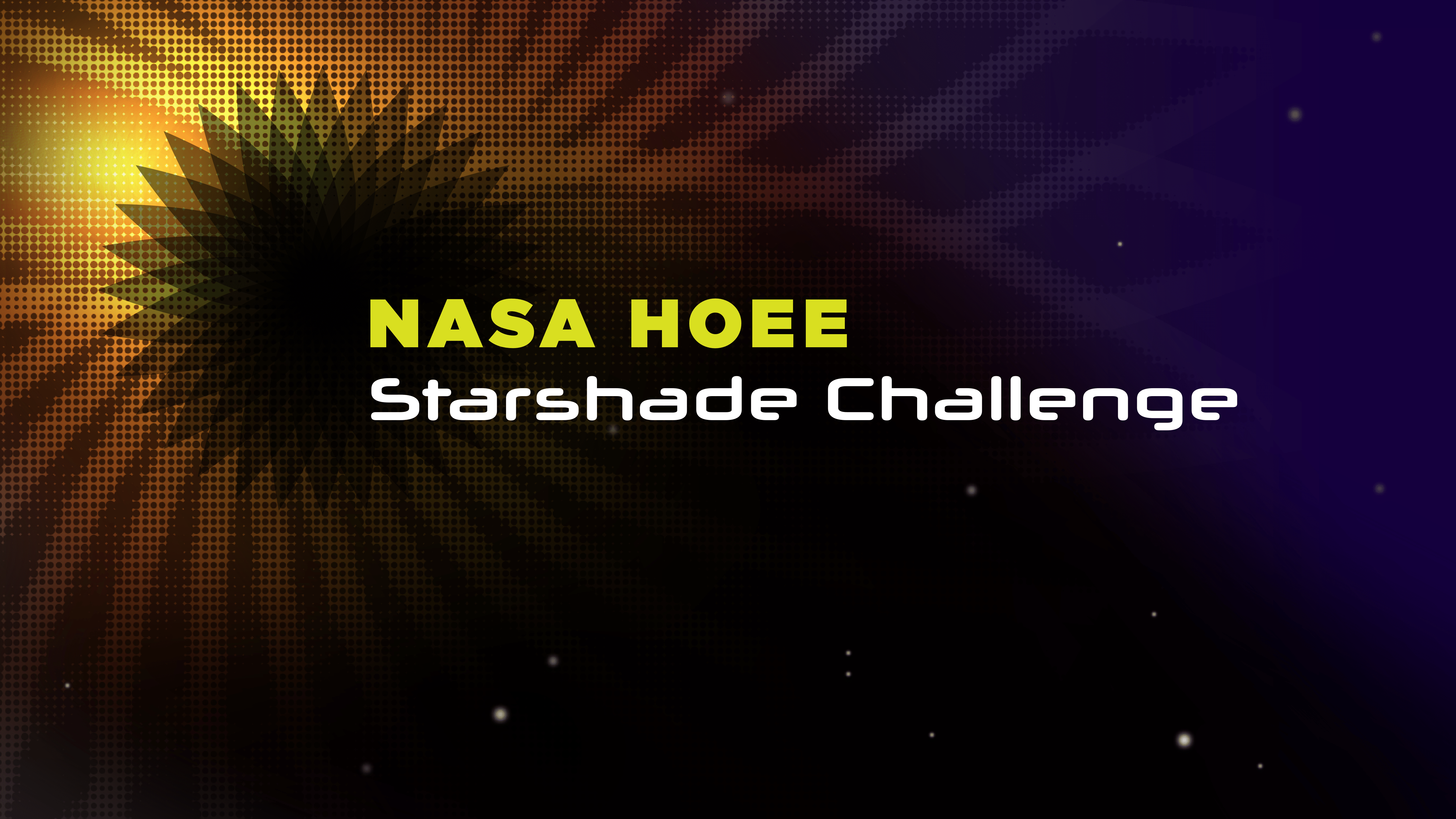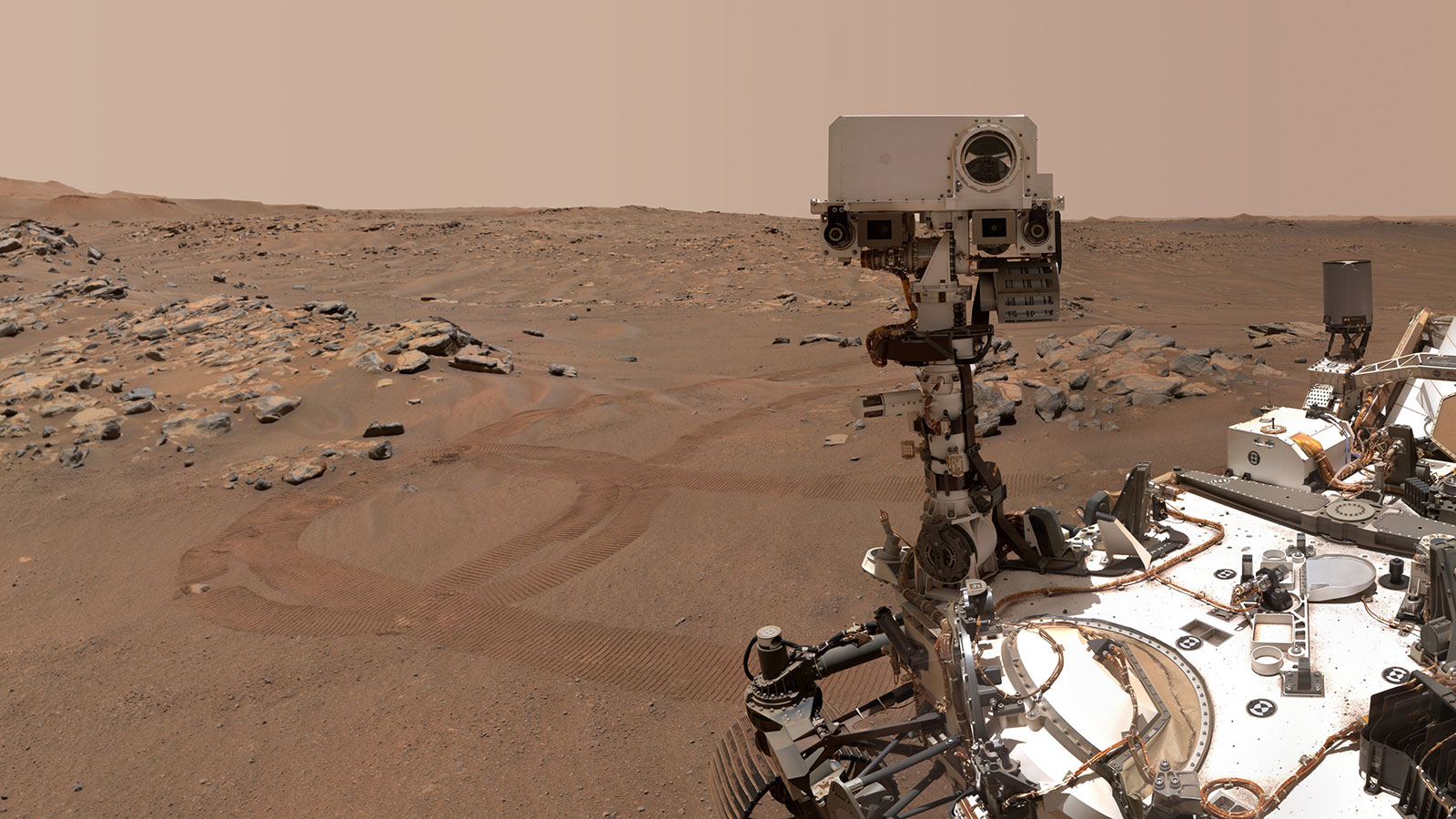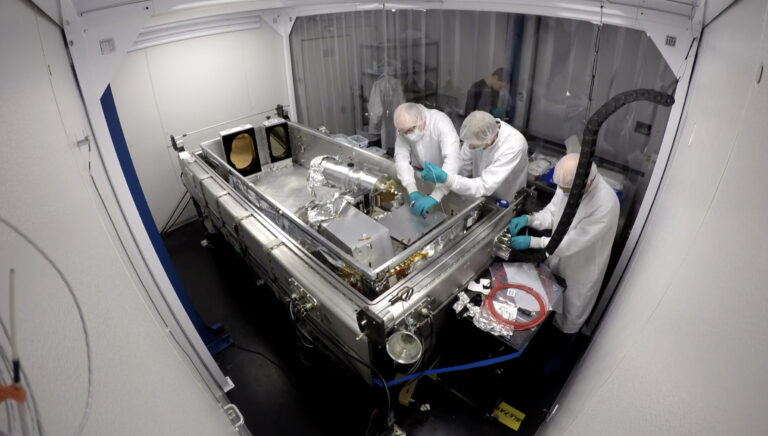A new research centre, led by the University of Adelaide, will focus international expertise on finding ways to provide the next generation of space explorers with nutritious foods, and the on-demand supply of materials and medicines.
Tag: Space
IceCube neutrinos provide new view of active galaxy
An international team of scientists, including researchers at the University of Adelaide, have gathered new evidence about the energetic core of an active galaxy millions of lights years away by detecting neutrino particles emitted by it.

Starshade Competition Challenges Students to Block Starlight for Observing Exoplanets
The Hybrid Observatory for Earth-like Exoplanets proposes pairing the newest and largest ground-based telescopes with a starshade orbiting Earth to obstruct the light from a host star to identify and characterize an exoplanet. AIP, with NASA and SPS, is organizing a competition for undergraduate students in the physical sciences to design such a starshade.
Astronomers Unveil New – and Puzzling – Features of Mysterious Fast Radio Bursts
More than 15 years after deep-space fast radio bursts were first discovered, their perplexing nature continues to surprise astronomers – and newly published research only deepens the mystery surrounding them.
DART section lead available to discuss upcoming asteroid impact experiment
On Sept. 26, the international community will watch as NASA’s latest spacecraft collides with an asteroid in an attempt to knock it off its orbit. Cristina Thomas, an assistant professor of astronomy and planetary sciences at Northern Arizona University and lead of…
Experts say the discovery of Earthbound asteroids and comets needs improvement; too many satellites could prevent discovery
A new survey of planetary defense experts from Apollo Academic Surveys and Olin College of Engineering reports that discovery of asteroids and comets needs improvement. In addition, the proliferation of commercial satellites could prevent them from identifying Earthbound asteroids and comets.
Color Change in Space Materials May Help Measure Degradation Remotely
For the next six months, a camera system on the exterior of the International Space Station (ISS) will be snapping photos of more than a dozen different material samples, gathering detailed information that will help researchers determine how – and why – the harsh conditions of space affect these materials.
Seeds in space: plant research on Artemis I mission
How will we grow food in space? That’s one question Michigan State University’s Federica Brandizzi has been particularly interested in solving.
Brandizzi, an MSU Foundation Professor in the College of Natural Science and the MSU-DOE Plant Research Laboratory, will be sending seeds on the Artemis I mission to better understand how to grow food during space travel.

New research sheds light on when Mars may have had water
Scientists on NASA’s Perseverance mission made a surprising discovery about the composition of rock in Jezero Crater, one that will help them get a better idea of when water existed on Mars, and ultimately, help them understand if the red planet was ever habitable to microbial life.
Mars model provides method for landing humans on Red Planet
A mathematical model developed by space medicine experts from The Australian National University (ANU) could be used to predict whether an astronaut can safely travel to Mars and fulfil their mission duties upon stepping foot on the Red Planet.
Chula Engineering Student Team Wins Runner-up Award at Spaceport America Cup 2022
A big round of applause to members of the Chulalongkorn University High Altitude Research Club – CUHAR from Aerospace Engineering (AERO), Chula International School of Engineering, who represented Thailand at the Spaceport America Cup 2022.
GW Experts Available to Discuss Russia Leaving the International Space Station
WASHINGTON (July 26, 2022) — Yuri Borisov, head of Russia’s space agency Roscosmos, has announced Russia will withdraw from the International Space Station after 2024 to focus on building a Russian orbiting station. Experts from the George Washington University’s Space…
WVU scientist says NASA’s Webb Telescope will boost space research at University, Green Bank Observatory
The first photos from NASA’s James Webb Space Telescope have given researchers the deepest and clearest infrared look into space to date. West Virginia University researcher Maura McLaughlin, distinguished professor of physics and astronomy at the Eberly College of Arts…
UNLV professor available for NASA James Webb Telescope comment
UNLV professor of physics and astronomy Jason Steffen is available to talk about the significance of the James Webb Space Telescope imagery, and how it broadens our understanding of the universe. Today is the day that scientists are saying could…
Capturing the onset of galaxy rotation in the early universe
As telescopes have become more advanced and powerful, astronomers have been able to detect more and more distant galaxies. These are some of the earliest galaxies to form in our universe that began to recede away from us as the universe expanded.
Smelly tablets survive better in space
After returning from their trip into space, tablets subjected to the harsh effects of cosmic radiation have shown some unexpected results: those with increased aroma were not degraded as much as those with less taste.
NASA’s Webb to Uncover Riches of the Early Universe
Telescopes have spotted many distant galaxies – but none earlier than 400 million years after the big bang. What were galaxies that existed even earlier like? Two research teams using the James Webb Space Telescope will wield its state-of-the-art instruments to reveal an untold number of details about this early period in the universe for the first time – and revise what we know about some of the earliest chapters of galaxy evolution.
Johns Hopkins Astronomers To Discuss New Satellite Galaxy Simulation
With a new simulation that shows how satellite galaxies orbit bigger galaxies like the Milky Way, Johns Hopkins University researchers have reconciled long-dueling visions of what astronomers actually see using telescopes and what theorists have predicted they should see.
Rapid-fire fast radio burst shows hot space between galaxies
A recently discovered, rare and persistent rapid-fire fast radio burst source – sending out an occasional and informative cosmic ping from more than 3.5 billion light years away – helps to reveal the secrets of the broiling hot space between the galaxies. That’s according to an international team of astronomers who published their findings in the journal Nature.
Build-a-satellite program could fast track national security space missions
Valhalla, a Python-based performance modeling framework developed at Sandia National Laboratories, uses high-performance computing to build preliminary satellite designs based on mission requirements and then runs those designs through thousands of simulations.
Finland’s first science satellite launches into space
The Foresail-1 mission will test a new plasma brake and collect data about space radiation
Story tips: Fueling up on savings, COVID’s behavior effect, cosmic collisions, seismic and sound, and space-to-ground comms
ORNL story tips: Fueling up on savings, COVID’s behavior effect, cosmic collisions, seismic and sound, and space-to-ground comms
Astronomers Closer to Unlocking Origin of Mysterious Fast Radio Bursts
Nearly 15 years after the discovery of fast radio bursts (FRBs), the origin of the millisecond-long, deep-space cosmic explosions remains a mystery. That may soon change, thanks to the work of an international team of scientists – including UNLV astrophysicist Bing Zhang – which tracked hundreds of the bursts from five different sources and found clues in FRB polarization patterns that may reveal their origin.
Sending Stem Cells Into Space to Develop Medicine of Tomorrow
Scientists from Cedars-Sinai are gearing up to send stem cells into space to test whether it is possible to produce large batches in zero gravity for use in treating a variety of diseases back on Earth.
Astro2020 prioritizes extraterrestrial life, diversity in astronomy
The newly released Astro2020 decadal survey has ranked the projects the astronomer community wants to prioritize for the next 10 years. The 614-page NASA-sponsored report highlights the search for extraterrestrial life, as well as stressing the need for greater diversity…
Laboratory Will Illuminate Formation, Composition, Activity of Comets
In Review of Scientific Instruments, researchers have developed a laboratory to simulate comets in space-like conditions. The goal of the Comet Physics Laboratory is to understand the internal structure of comets, as well as how their constituent materials form and react. Many of the lab’s future experiments will involve creating sample comet materials with differing compositions. By testing those materials in the space-like chamber, the researchers can compare each sample to what has been observed on actual comets.
Need for Larger Space Telescope Inspires Lightweight Flexible Holographic Lens
Inspired by a concept for discovering exoplanets with a giant space telescope, a team of researchers is developing holographic lenses that render visible and infrared starlight into either a focused image or a spectrum.
Sanford Burnham Prebys professor Karen Ocorr awarded $2 million from NASA to study flies in space
As part of their larger initiative to understand the effects of space conditions on different organisms, NASA has awarded $2 million to Sanford Burnham Prebys assistant professor Karen Ocorr. The grant will fund a three-year project to study the effects of low gravity on muscle and neuron function in fruit flies and nematode worms aboard the International Space Station.
Gigantic Cavity in Space Sheds New Light on How Stars Form
Astronomers have discovered a humongous cavity in space while mapping interstellar dust. The sphere-shaped phenomenon may explain how supernovae lead to star formation.
SpaceX crew launch signals future of sustainable space exploration
SpaceX is expected to make history tonight with the first all-civilian crew launched into orbit. Mason Peck is a professor of astronautical engineering at Cornell University and previously served as NASA Chief Technologist. Peck says the future of sustainable space exploration is upon…
Affordable housing in outer space: Scientists develop cosmic concrete from space dust and astronaut blood
Transporting a single brick to Mars can cost more than a million British pounds – making the future construction of a Martian colony seem prohibitively expensive.
What has been discovered about the Mars surface? How does that relate to human missions?
Soil on Mars is different than soil on Earth, and exploration is helping us learn more
Geologists propose theory about a famous asteroid
Vesta was hit by two other large asteroids which left large impact craters so big they cover most of the southern hemisphere of Vesta. These impacts are thought to have ejected rocky material into space. Some of these rocks reached Earth as meteorites so scientists now have actual rock samples from Vesta to study its geochemistry.
Countdown to launch: Cornell scientists play key roles in James Webb Space Telescope
NASA’s James Webb Space Telescope — the largest and most powerful space science observatory ever built — is designed to give astronomers unprecedented insight into the mysteries of the cosmos. Webb is an international program led by NASA with its…
Cosmic Rays May Be Key to Understanding Galactic Dynamics
While moving around within the gas in the interstellar medium, cosmic rays kickstart the background protons, which causes a collective plasma wave movement akin to ripples on a lake. The big question is how cosmic rays deposit their momentum into the background plasma. In Physics of Plasmas, plasma astrophysicists review recent developments within the field of studying the streaming instability triggered by cosmic rays, which likely have more impacts on galactic dynamics and the star formation cycle than previously known.
Dragonfly mission to Titan announces big science goals
NASA’s Dragonfly mission, which will send a rotorcraft relocatable lander to Titan’s surface in the mid-2030s, has big goals.
NASA Model Describes Nearby Star Which Resembles Ours in Its Youth
New research led by NASA provides a closer look at a nearby star thought to resemble our young Sun.
Space Race with China: expert talk & interview availability
A New Space Race? Rediscovering Star Wars and the new High Frontier Tuesday, July 13 at 4PM EDT. The Foreign Press Association is hosting a critical talk by space policy and business expert Professor Greg Autry on China’s advances in…
‘There may not be a conflict after all’ in expanding universe debate
In a new review paper accepted to the Astrophysical Journal, Freedman gives an overview of the most recent observations. Her conclusion: the latest observations are beginning to close the gap. That is, there may not be a conflict after all, and our standard model of the universe does not need to be significantly modified.
Life in these star-systems could have spotted Earth
Scientists at Cornell University and the American Museum of Natural History have identified 2,034 nearby star-systems – within the small cosmic distance of 326 light-years – from which life could find Earth merely by watching our pale blue dot cross our sun.
Space bubble experiment could lead to more effective early cancer screenings
The study, led by Tengfei Luo, a professor in the Department of Aerospace and Mechanical Engineering at the University of Notre Dame, will be initiated by astronauts aboard the International Space Station (ISS).
UNLV Engineering and Dental Researchers Team with NASA, Colgate on June 3 Space Launch
First-of-its-kind device developed by UNLV for International Space Station experiment will test microgravity and Earth differences in growth and treatment of oral bacteria.
36 Dwarf Galaxies Had Simultaneous “Baby Boom” of New Stars
Three dozen dwarf galaxies far from each other had a simultaneous “baby boom” of new stars, an unexpected discovery that challenges current theories on how galaxies grow and may enhance our understanding of the universe. Galaxies more than 1 million light-years apart should have completely independent lives in terms of when they give birth to new stars. But galaxies separated by up to 13 million light-years slowed down and then simultaneously accelerated their birth rate of stars, according to a Rutgers-led study published in the Astrophysical Journal.

UCI-led team challenges existence of recently proposed exoplanet at Barnard’s star
In 2018, astronomers announced that they had discovered an exoplanet orbiting Barnard’s star, our solar system’s second-closest stellar neighbor, but further analysis by an international group of researchers headed by a graduate student at the University of California, Irvine has cast doubt on the finding.

Dark Energy Spectroscopic Instrument team begins 3D mapping of universe
Irvine, Calif., May 18, 2021 — The Dark Energy Spectroscopic Instrument collaboration launched a new era in cosmology today with a five-year endeavor to construct the largest three-dimensional map of the universe. Comprised of nearly 500 scientists from around the globe, including astronomers at the University of California, Irvine, the DESI group will collect spectral data from more than 30 million galaxies to study dark energy, an as-yet-unknown substance believed to be causing the expansion of the universe to accelerate.
Chula Unveils World-Class Innovative Prosthesis Made by Thais
April 9, 2021 – Chula holds the 4th CHULA the Impact Seminar entitled “World–Class Innovative Prosthesis Made by Thais” showcasing the capabilities of Chula researchers from Chula Engineering Enterprises
Rutgers Expert Available to Discuss Supernova Discovery
New Brunswick, N.J. (April 21, 2021) – Rutgers University–New Brunswick astrophysicist John P. (Jack) Hughes is available for interviews on a supernova (exploding star) discovery published today in the journal Nature. The discovery, made with NASA’s Chandra X-ray Observatory, features…
Experimental Biology 2021 Press Materials Available Now
Embargoed press materials are now available for the virtual Experimental Biology (EB) 2021 meeting, featuring cutting-edge multidisciplinary research from across the life sciences. EB 2021, to be held April 27–30, is the annual meeting of five scientific societies bringing together thousands of scientists and 25 guest societies in one interdisciplinary community.
Expert in Industry of Outer Space, Greg Autry Joins Thunderbird School of Global Management at ASU
Press Release Announcement: Space-Sector Expert Joins ASU Thunderbird

Interception mission to confirm ‘Oumuamua, other interstellar objects, in the works
CHICAGO – ‘Ouamuamua, the first observed interstellar object, zipped through our solar system back in October 2017 — and astronomers have been trying to understand it ever since. While some researchers speculated it could be a comet, asteroid, or even…